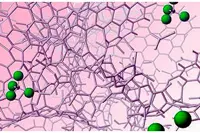 Researchers from the University of Cambridge, together with French collaborators based in Toulouse, have developed a method that allows the inside of supercapacitors to be viewed at the atomic level. The team says this approach could be used in order to optimise and improve the devices.
Researchers from the University of Cambridge, together with French collaborators based in Toulouse, have developed a method that allows the inside of supercapacitors to be viewed at the atomic level. The team says this approach could be used in order to optimise and improve the devices.
By using a combination of nuclear magnetic resonance (NMR) spectroscopy and scales sensitive enough to detect changes in mass of a 1µg, the researchers could visualise how ions move around in a supercapacitor. They found that, while charging, different processes are at work in the two identical pieces of carbon 'sponge' which function as the electrodes.
Dr John Griffin, a postdoctoral researcher in the Department of Chemistry, said: "[Supercapacitors are] much better at absorbing charge than batteries, but since they have much lower density, they hold far less of that charge. Being able to see what's going on inside these devices will help us to control their properties, which could help to make them smaller and cheaper, and that might make them a high power alternative to batteries."
When a supercapacitor is being charged, ions 'stick' to the surface' when being discharged, they 'hop' off the surface and move back into the electrolyte.
"To increase the area for ions to stick to, we fill the carbon electrode with tiny holes, like a carbon sponge," said Dr Griffin. "But it's hard to know what the ions are doing inside those holes."
In their study, the researchers used NMR to look inside functioning supercapacitors to see how they charge and store energy and an electrochemical quartz crystal microbalance to measure changes in mass.
From the two sets of information, the researchers built a precise picture of what happens inside a supercapacitor while it charges.
"In a battery, the two electrodes are different materials, so different processes are at work," said Dr Griffin. "In a supercapacitor, the two electrodes are made of the same porous carbon sponge, so you'd think the same process would take place at both – but it turns out the charge storage process is more complicated than we previously thought."
The experiments showed the two electrodes behave differently: in the negative electrode, positive ions are attracted to the surface as the supercapacitor charges. But in the positive electrode, an ion 'exchange' happens, as negative ions are attracted to the surface, while at the same time, positive ions are repelled.
The team will now try to understand why different ions behave differently on charging and attempt to design systems with higher performance.
Author
Graham Pitcher
Source: www.newelectronics.co.uk

